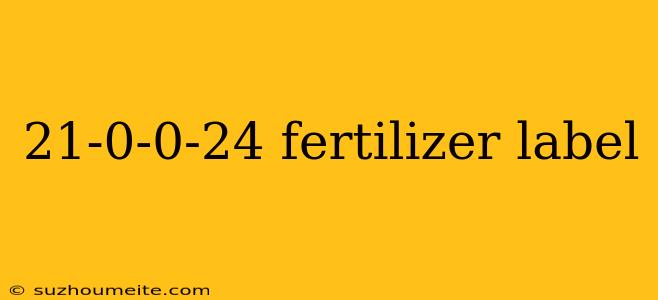Understanding the 21-0-0-24 Fertilizer Label
When it comes to fertilizers, the label can be overwhelming with numbers and codes. As a farmer or gardener, it's essential to understand what these numbers mean to make informed decisions about the nutrients your plants need. In this article, we'll break down the 21-0-0-24 fertilizer label and explain what each number represents.
The NPK Formula
The first three numbers on a fertilizer label represent the NPK formula, which stands for Nitrogen (N), Phosphorus (P), and Potassium (K). These three macronutrients are essential for plant growth and development.
Nitrogen (N)
- 21 represents the percentage of nitrogen in the fertilizer. Nitrogen is responsible for promoting leaf growth, green color, and overall plant development.
Phosphorus (P)
- 0 indicates that this fertilizer does not contain phosphorus. Phosphorus is crucial for root development, flower and fruit production, and overall plant maturity.
Potassium (K)
- 0 also indicates that this fertilizer does not contain potassium. Potassium helps with overall plant health, resistance to disease, and water balance.
The Fourth Number: Sulfur (S)
The fourth number on the label, 24, represents the percentage of sulfur in the fertilizer. Sulfur is a secondary macronutrient that plays a vital role in plant growth and development. It helps with:
- Protein synthesis
- Enzyme function
- Flower and fruit production
- Resistance to disease
What Does it All Mean?
The 21-0-0-24 fertilizer label tells us that this product is a nitrogen-rich fertilizer with a high sulfur content, but it does not contain phosphorus or potassium. This type of fertilizer is suitable for plants that require a lot of nitrogen, such as:
- Leafy greens
- Corn
- Small grains
- Tobacco
Conclusion
Understanding the 21-0-0-24 fertilizer label is crucial for making informed decisions about the nutrients your plants need. By recognizing the NPK formula and the additional secondary macronutrients like sulfur, you can choose the right fertilizer for your specific crop or plant needs. Remember to always follow the instructions on the label and take necessary precautions when handling fertilizers.
